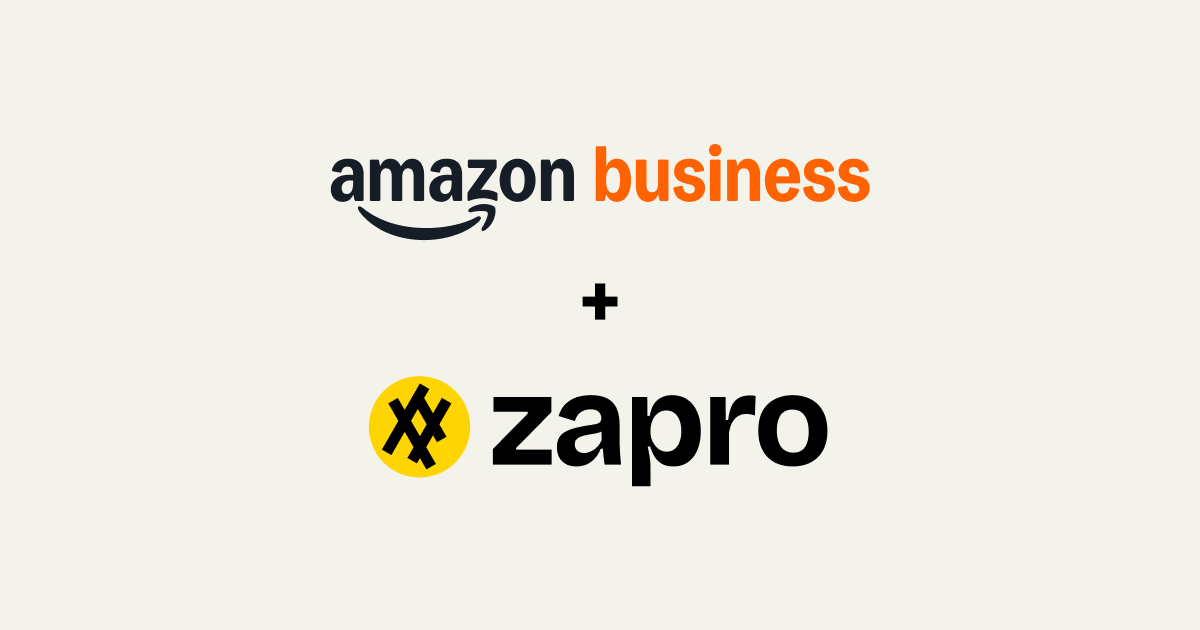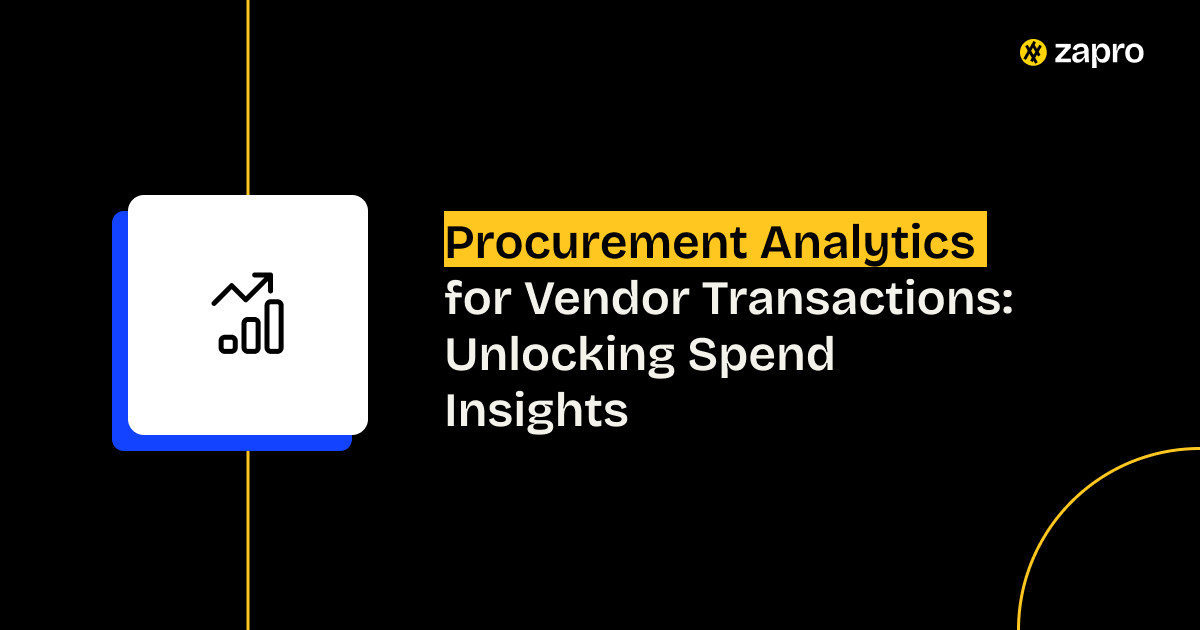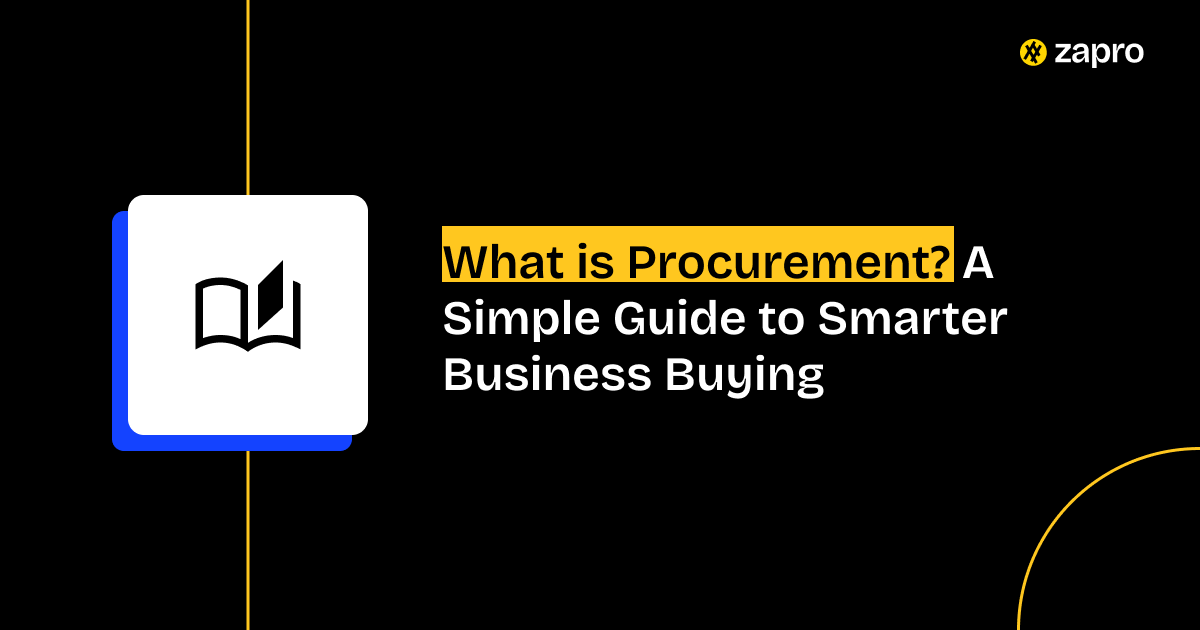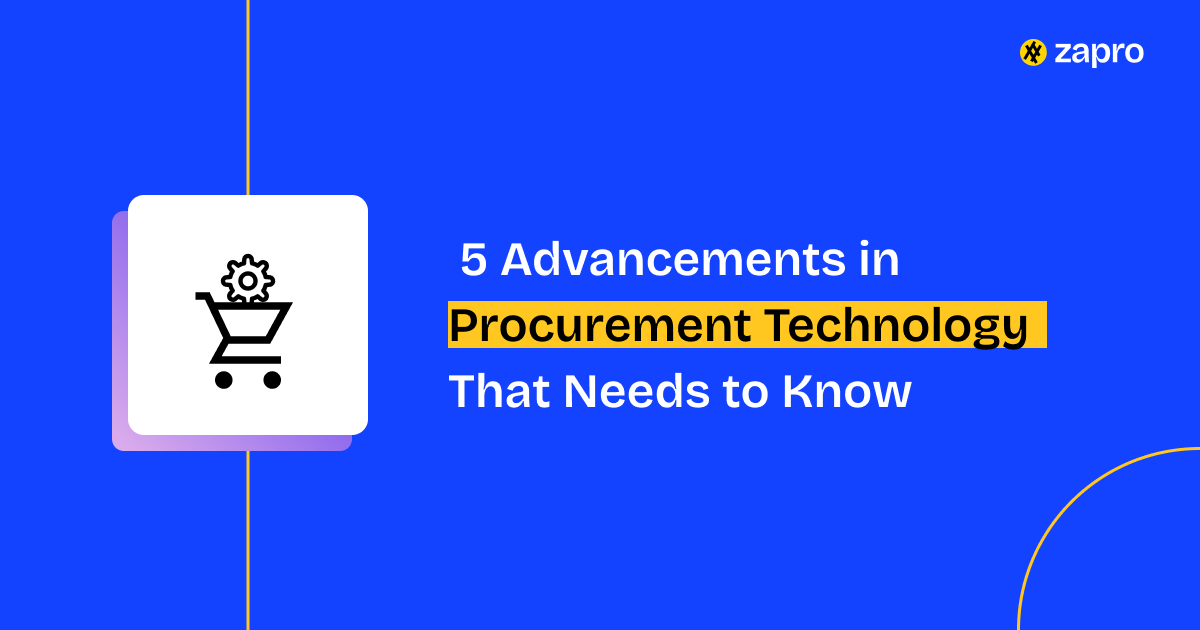Key takeaways
- Modern procurement analytics reveals strategic value in vendor transaction data when properly analyzed.
- The analysis of procurement data requires organizations to maintain clean and categorized information which should be stored in a centralized system for accurate results and improved supplier control.
- The analysis of data through analytics helps organizations detect payment leaks while optimizing payment schedules and strengthening their negotiation abilities through enhanced visibility.
- Real-time decision-making and collaboration becomes possible through integrated tools which establish connections between ERP systems and Vendor Management Systems.
- Organizations need to establish strong governance systems and measure performance through KPIs while achieving cross-functional alignment to develop a data-based procurement culture.
- Zapro provides organizations with the ability to transform unprocessed spend information into predictive actionable insights which drive ongoing improvement efforts.
The untapped potential of your vendor transaction data
The vendor transaction data collected by your organization remains unexplored for its full value potential.
Procurement teams accumulate extensive vendor transaction information through purchase orders and invoices and payments and performance metrics yet they only use a small portion for decision-making. The data exists in separate systems which prevent organizations from accessing essential information about their spending efficiency and supplier dependability and operational performance.
Vendor transaction data analysis reveals its potential to become a valuable business resource. The analysis of this data reveals hidden patterns which help organizations detect inefficient costs and detect supplier vulnerabilities that manual reviews cannot detect. Procurement analytics transforms unprocessed data into strategic business intelligence which enhances procurement life cycle vendor performance and spend visibility.
Moving beyond basic reporting
Basic reports present historical data about total expenses and leading suppliers and transaction amounts. Useful, but not enough. The system generates explanations about previous events and recommends future actions.
The combination of data modeling with visualization techniques reveals concealed patterns which show that supplier delivery delays create payment problems and increase product defects. The system detects unauthorized purchasing activities which occur outside of approved procurement channels. The transition from basic reporting to predictive analytics enables procurement leaders to make swift decisions based on concrete evidence.
Why procurement analytics is essential for modern business
The current procurement environment requires organizations to achieve speed and manage costs while predicting future events. Analytics delivers complete solutions for all three requirements. The system integrates data from ERP systems and E-procurement Software and Vendor Management Tools into one unified database.
Organizations gain clear visibility which enables them to track procurement KPIs and assess supplier performance and predict market requirements with better precision. A data-based procurement operation emerges which reduces waste while enhancing supplier relationships and actively handles potential threats to achieve market success in today’s unpredictable business environment.

In just the last 12 months, sourcing and procurement leaders cite a 69% increase in the importance of data and technology competencies.
Key pillars of effective procurement analytics
The development of effective procurement analytics requires organizations to establish clean and structured data that maintains consistent formatting. The absence of proper data foundation prevents advanced tools from generating useful analytical results. Organizations achieve strategic intelligence through these three essential pillars which transform vendor transaction data into valuable insights.
1. Data collection and cleansing: the foundation
The procurement data originates from various systems which include ERP systems and Vendor Management Systems and invoices and contracts and supplier portals. The analysis becomes unreliable because of different data formats and duplicate entries and missing information create inconsistencies.
A systematic approach to data collection and cleansing maintains both accuracy and reliability in the data. The process standardizes fields while eliminating errors and uniting data from various systems into one database. The main objective of this process is to establish a single reliable dataset which serves as the foundation for analytics. The procurement team achieves better spend pattern tracking and supplier performance evaluation and compliance monitoring through high-quality data.
2. Spend categorization and classification
The analysis of unorganized spend data makes it challenging to determine actual spending destinations. The process of categorization and classification organizes purchasing activities through defined categories which include direct and indirect and service-based expenses and uses standardized taxonomies like UNSPSC or custom organizational systems.
The process reveals cost reduction possibilities and helps organizations remove unnecessary suppliers while enabling them to evaluate their performance across different categories. The combination of analytics tools with categorized spend data enables organizations to obtain detailed insights about their purchasing patterns and contract compliance and potential consolidation opportunities.
3. Supplier segmentation and performance data
The business value that suppliers deliver to the organization varies significantly between different suppliers. The segmentation process enables organizations to separate suppliers based on their spending levels and their risk exposure and operational performance and their strategic value to the company.
Businesses can assess suppliers through performance metrics which include delivery timeliness and defect rates and cost differences.
The process enables organizations to create improved sourcing plans and develop specific improvement initiatives and conduct better negotiations. The process of supplier segmentation creates a performance-based system which organizations use to handle their relationships and manage risks effectively.
Unlocking actionable insights from vendor transactions
Systematic analysis of vendor transaction data produces essential information which enables organizations to enhance their financial management and build stronger relationships with suppliers and make better procurement choices.
The insights generated from procurement leaders can be used to forecast market patterns and detect operational waste and execute immediate spend optimization.
1. Spend leakage and maverick buying identification
Spend leakage happens when organizations make purchases through channels that violate their established contracts and negotiated rates. The practice of unauthorized buying creates additional expenses which simultaneously weakens organizational compliance standards.
The system uses transaction data to check vendor compliance against approved lists and contract terms and category limits. The system reveals non-compliant transactions while showing unapproved suppliers and shows the exact amount of financial loss. Organizations that monitor their transactions continuously can maintain policy adherence while recovering substantial amounts of concealed value.
2. Payment term optimization and discount discovery
Vendor transaction analytics reveal cash flow management problems which organizations can solve. The evaluation of payment patterns together with early payment behavior and invoice cycles enables procurement teams to establish new payment terms which benefit both parties.
The identification of vendors who provide early payment discounts allows treasury teams to enhance their working capital management. The system reveals which payment delays harm supplier relationships and result in lost discount potential. The organization achieves financial goal alignment with vendor performance targets through data-based payment strategy management.
3. Consolidating spend and negotiating better deals
The process of uniting purchasing activities under single suppliers enables organizations to obtain improved purchasing terms.
The process of vendor transaction data consolidation enables procurement teams to use their combined purchasing power for better contract terms and service agreements. The combination of vendor transactions under single suppliers enables organizations to obtain improved pricing and service agreements. The consolidation of spend activities decreases administrative costs and makes supplier management more efficient which results in a stronger supply chain.
4. Predicting future demand and supplier capacity
The system uses predictive models to generate future market trend forecasts.
The system uses historical spending data together with delivery time information and seasonal patterns to create better forecasts for demand and supplier capacity assessment.
The system enables organizations to develop procurement strategies that match their production needs and market conditions thus avoiding stockouts and excessive inventory. The system allows organizations to start supplier outreach before operational challenges emerge from capacity limitations or potential risks.
Can’t See Where Your Procurement Budget Goes? Fix That Today.

Tools and technologies for procurement analytics
The analysis of procurement data through modern analytics systems depends on sophisticated technological solutions which convert unprocessed transaction information into valuable business insights. The correct tools enable fast data processing and complete system integration which creates a unified accurate database for procurement decision support.
A robust analytics platform requires three essential elements which include scalability and automation and user-friendly functionality.
1. Core features of a robust analytics platform
The platform includes several essential features which enable its operation.
- The platform unites data from different systems including ERP and E-procurement Software and Supplier Management Software into a single database.
- The system performs automatic data cleaning and enhancement to preserve data precision and maintain uniformity between different information sources.
- The system provides sophisticated visualization tools and dashboard capabilities which enable users to understand complex metrics through immediate access to real-time information.
- The system performs predictive and prescriptive analytics to create future projections and risk assessments and generate recommendations for sourcing and payment optimization.
- The system allows users to create customizable procurement performance indicators and reports which monitor spending effectiveness and supplier reliability and regulatory compliance.
The combination of these features enables procurement teams to transition from manual data evaluation to strategic decisions based on analytical insights.
2. Integration with ERP and VMS systems
The system connects to ERP and VMS systems for operation.
The complete integration of procurement analytics with current enterprise systems produces its highest possible benefits. The connection between analytics platforms and ERP systems enables financial and operational data to move automatically between purchasing and accounting and supply chain operations.
The integration of VMS systems with procurement analytics platforms provides complete visibility into supplier performance and contract compliance and risk assessment capabilities. The integrated system removes information barriers which enable procurement staff to work with finance personnel and vendor management experts through instant teamwork.
Digital transformation of organizations enables these system connections to establish a continuous improvement process which converts analytics into a strategic procurement excellence tool.
Building a data-driven procurement culture
The implementation of procurement analytics requires an organizational culture which supports data integrity and team collaboration and ongoing improvement initiatives. The development of this culture needs both leadership support and systematic execution methods.
1. Best practices for implementation and adoption
The development of a data-driven procurement culture needs time to establish itself. The process starts with specific targets and follows a systematic approach to implementation.
The following essential practices help organizations achieve faster adoption of their procurement systems:
- The organization needs to establish robust data governance systems which determine ownership responsibilities and validation procedures and data quality requirements for procurement and finance and vendor teams.
- The organization needs to train its staff members about analytics basics so they can understand dashboard data and detect unusual patterns and execute decisions based on analysis results.
- The implementation of measurable KPIs should begin with essential procurement performance indicators which include spend under management and contract compliance and cost avoidance to show immediate value.
- The organization should unite different departments through data-sharing initiatives that link procurement information with financial data and operational metrics and supplier performance results.
- Organizations should select Procurement Software and Vendor Management Tools which provide automated data collection and visualization and reporting capabilities.
The implementation of these practices enables analytics to shift from reporting isolation into a permanent performance enhancement system.
2. Case studies: Success stories in spend optimization
Organizations that use analytics for their procurement operations achieve concrete benefits through their reduced maverick spending and accelerated procurement cycles and enhanced supplier relations.
The fertility care provider Repromed serves as an example of successful implementation. The procurement operations at Repromed became more efficient and transparent and their teams started working better together after implementing Zapro.
| “Zapro made procurement effortless with a user-friendly interface and stellar support. Our team and suppliers adapted quickly, and we’re now seeing faster approvals and smoother collaboration.”— Maria Rowan, Business Controller, Repromed |
The success story demonstrates how Zapro and similar analytics platforms achieve user-friendly operation through intelligent system integration with ERP and Vendor Management Systems to transform procurement data into strategic business decisions.
Organizations that base their decisions on data will achieve better spend optimization and develop stronger supplier relationships and achieve higher operational efficiency and better business resilience.
Implementing smarter procurement analytics with Zapro
Zapro enables organizations to achieve better procurement analytics through its implementation.
Organizations need procurement analytics to establish their intelligent and agile and profitable operations. A platform which combines data unification with automated insight generation and simplified collaboration enables organizations to achieve their maximum potential. Zapro provides unique capabilities beyond standard procurement tools.
Zapro operates as an analytics-based system which functions as a complete procurement solution. The platform unites all vendor information and spending data into a user-friendly interface which converts complicated data into useful business decisions.
Zapro enables organizations to achieve the following benefits through its advanced dashboards and predictive insights and its seamless integration with ERP and Vendor Management Systems:
- Instant access to vendor and spend data – The system provides instant access to vendor performance data and spending patterns.
- Early detection of inefficiencies – The system identifies potential operational problems through its ability to detect maverick buying activities and delayed payment events at their onset.
- Automated KPI tracking and compliance reporting – The system performs automated tracking of KPIs and generates reports for compliance purposes.
- Improved supplier collaboration – The system enables organizations to build better supplier relationships through their ability to share data transparently.
- Quantifiable cost reduction – The system enables organizations to achieve quantifiable cost reductions and enhanced procurement results.
The platform enables procurement teams to shift from basic transaction management to strategic planning through data-driven decision making for every business deal.
Ready to transform your vendor analytics strategy?
Explore how Zapro’s Procurement Analytics Platform can help you unlock spend insights, improve supplier collaboration, and build a truly data-driven procurement function.

Stop Manually Analyzing Spend. Start Getting Automatic Insights.
Zapro delivers AI-powered procurement analytics for every vendor transaction & track spending
Don’t miss our weekly updates
We’ll email you 1-3 times per week—and never share your information.

 Healthcare
Healthcare Financial Services
Financial Services Technology
Technology Venture Capitalist
Venture Capitalist Chief Procurement Officer
Chief Procurement Officer Chief Financial Officer
Chief Financial Officer




